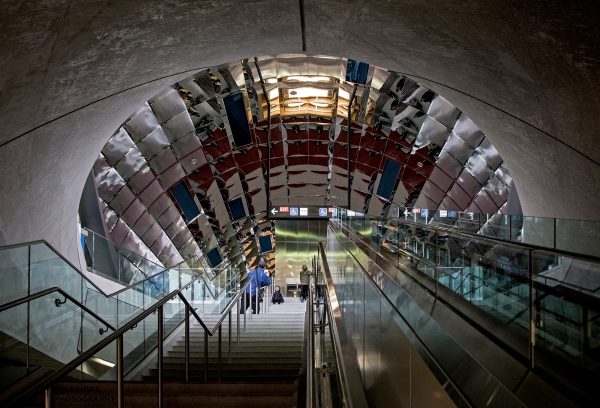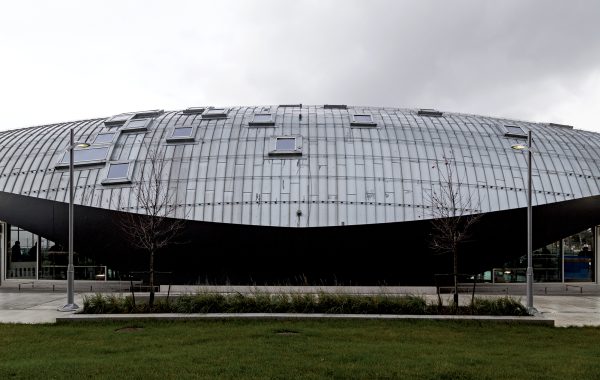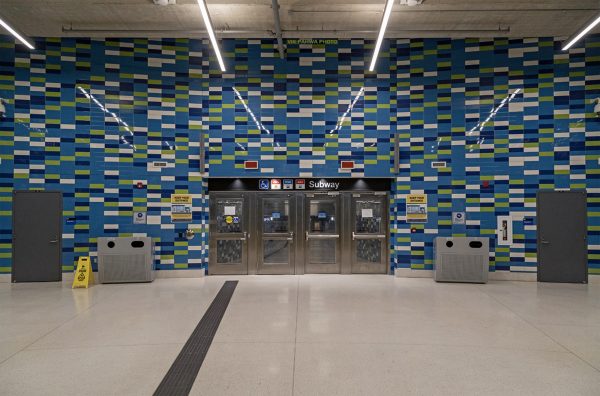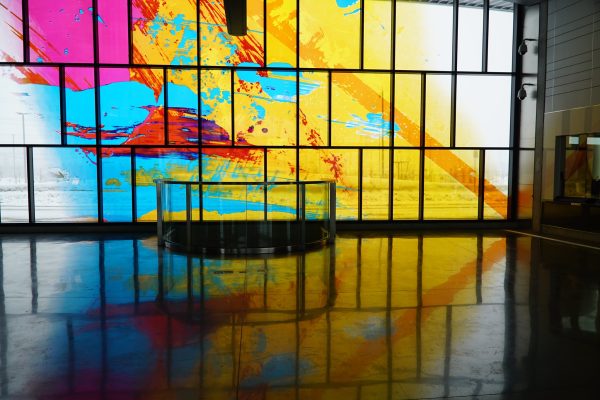Inside the Vaughan Metropolitan Centre Station’s airy concourse, architecturally integrated public artwork, Atmospheric Lens, transforms the mundane commute into an experience of unexpected wonder. Incorporated into the station’s ceiling, Atmospheric Lens masterfully conjures the celestial, its luminous dome of skylights and mirror polished steel panels merging sky and station in a distorted collage of natural light and passing commuters. At once a literal and symbolic evocation of the sky, Atmospheric Lens integrates human and celestial movement into an uncanny representation that is both estranged from and entangled with its subjects.
A joint venture between architecture firms Grimshaw and Paul Raff Studio, the artwork’s seamless integration into the station’s metallic roof testifies to its collaborative design. Surrounded by an increasingly dense grid of high-rise buildings, the station sits comparatively low to the ground. Evoking both the subtle curvature of a contact lens and the sleek minimalist lines of a futuristic space shuttle, Atmospheric Lens can only be appreciated in its entirety from the station’s interior. By reflecting and filtering natural light through breaks in its reflection, it assumes the role both of the ideal art-making surface and of the ideal art-making environment, an environment in which commuters serve as living, kinetic media. Rather than simply complementing the station, Atmospheric Lens inverts the station’s roof, assuming the form of its viewing context: a mock-sky reflecting a dynamic array of splintered reflections that colour the artwork’s kaleidoscopic canvas.
Spatially configured to maximize natural light throughout the year, blue skylights map their coordinates across a soaring grid of horizontal and vertical axes like sun-soaked pools of water dispersed across a suburb of reflective panels. Lined with mirror-polished steel and placed perpendicular to the roof, the skylight coffers are comprised of three different blue hues. Architect and artist Paul Raff described the skylights as “the colour of mirror-polished steel. We sampled different types of sky blues and had the mirror panels coloured in intensive sky colours. They’re a couple of different hues of blue.” At night, the skylights reveal another deftly integrated architectural element: “There is concealed artificial light in the coffers as well.” When passing below, these lights appear to twinkle like a flickering constellation of stars. Paul Raff draws attention to an additional feature: “There’s a round glowing amber light that is hidden on top of an elevator shaft in the station, so at certain angles you’ll see a kind of glowing round circle in the sky like a glowing sun or moon. You can’t tell where it’s coming from. That’s part of the idea… it looks like a glowing celestial orb.” Not immediately apparent to the naked eye, the origin of this light lends an air of mystery to the ethereal artwork, inviting commuters to contemplate its symbolic significance.
At Vaughan Metropolitan Station, aesthetic intention is not an afterthought, but a fundamental component of the station’s construction. Accented with spots of blue, white, and amber, Atmospheric Lens conjures the celestial, its expansive interior softening the divide between subterranean and surface. Inviting commuters to engage with their environment, Atmospheric Lens brings a sense of wonder to the daily ritual, exciting the imagination in an environment that would otherwise leave it wanting. Subway stations need not be drab, dehumanizing spaces devoid of inspiration. They can be works of art that defy their contextual conventions. Unconfined by the gallery’s rarefied walls, public art resides in myriad impressions of spaces seldom associated with the aesthetic.
Entering the station from the street, commuters may perceive the Atmospheric Lens almost peripherally, a series of disjointed fragments cutting through a throng of downcast faces. Entering the station from the subway, however, commuters may perceive the artwork as an expanding presence, its towering dome lending an almost Odyssean weight to an otherwise mundane journey. Ascending an Escheresque series of stairs and escalators, commuters bear witness to reflected and filtered natural light glancing off the metallic surfaces that permit their gradual ascent, the confines of the subway’s garish fluorescence gradually giving way to the artwork’s diffuse silvery light. Framed by an elliptical concrete arch, Atmospheric Lens emerges cathedralic overhead, its farthest vertical divisions appearing to radiate from and converge at the artwork’s base, the horizon line, like the striations of a corrugated shell. Intercepted by curving bands of growth, these vertical divisions appear to widen towards the upper edge of the concrete arch before vanishing under its enigmatic hood.
The use of reflective surfaces to direct light into urban spaces otherwise deprived of natural light is not unprecedented. Rjukan, a Norwegian town nestled in the shadow of a mountain for half the year, uses massive mirrors for a similar, though purely utilitarian, purpose: to direct sunlight onto its darkened streets. Vaughan Metropolitan Station contends with shadow-makers of an entirely different kind: high-rise buildings. Although they provide welcome respite from the sun’s intensity during the summer, high-rise buildings cast long shadows over lower buildings, blocking scarce winter sunlight. Paired with periods of direct sunlight, these shadows present a complex challenge wherein sufficient sunlight must be filtered and reflected to reach the station’s depths, without overheating the station’s interior. To manage a climate of increasing extremes, Grimshaw has fulfilled Toronto Green Standards, mitigating the ill effects of concentrated heat in urban centers by lowering ambient surface temperature.
Rather than appear to be a mere deprivation of light, shade must be artfully interspersed with areas of light. The blue skylights seem primed to address both the practical and aesthetic challenges. In the darker months, blue enlivens the diffuse wash of gray light. In warmer months, the cool colours temper the sunlight’s direct and relentless glare.
A harmonious marriage of art and architecture, Atmospheric Lens brings sunlight’s natural brilliancy to an underground area that otherwise would have relied solely on harsh electric lights. It harnesses light’s most favourable qualities while mitigating its increasing intensity to create a space that achieves both practical and aesthetic ends. Atmospheric Lens is in equal parts efficient and entrancing.
top and middle photos by Vik Pahwa; bottom photo by Moody Camera (cc)








One comment
Sinead Doherty-Grant has piqued my interest and added a must-see collaboration of art and architecture to our next trip to Toronto. Great article!